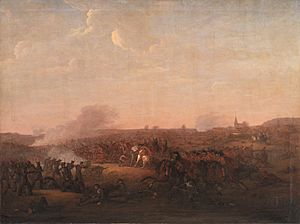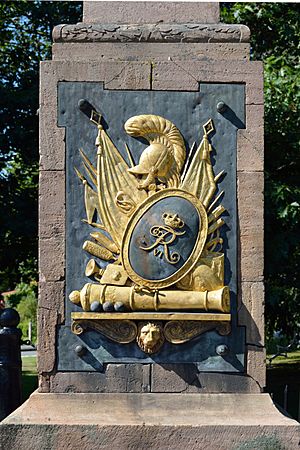Battle of Sehested facts for kids
Quick facts for kids Battle of Sehested |
|||||||
|---|---|---|---|---|---|---|---|
| Part of the War of the Sixth Coalition | |||||||
 Slaget ved Sehested, by Jørgen V. Sonne |
|||||||
|
|||||||
| Belligerents | |||||||
| Commanders and leaders | |||||||
| Strength | |||||||
| 9,000–11,000 men | 10,000–10,500 men Bodart: 4,000 |
||||||
| Casualties and losses | |||||||
| 50–69 killed 273–319 wounded 146 missing Total: 500 |
522 killed or wounded 600 captured Total: 1,100 |
||||||
The Battle of Sehested was a fight between Danish and allied forces. The allied forces included soldiers from Russia, Prussia, Britain, Hanover, and Mecklenburg-Schwerin. The battle happened in Sehested, a town in Holstein, on December 10, 1813. It was part of the larger War of the Sixth Coalition.
The Danish army, which was fighting alongside the French, won this battle. They defeated the allied forces led by Major General Ludwig von Wallmoden-Gimborn. However, this victory did not change the overall outcome of the war. Denmark eventually lost the war in 1814.
Contents
Why the Battle Happened
The kingdom of Denmark-Norway got involved in the Napoleonic Wars after a big event in 1807. The United Kingdom attacked Copenhagen to stop the Danish-Norwegian fleet from falling into Napoleon's hands. This attack pushed Denmark-Norway to join forces with France.
Even though Denmark was allied with France, their king, Frederick VI, tried to keep his country out of too many battles. Danish troops mostly served as occupation forces in northern Germany.
After Napoleon's army was defeated in Russia in early 1813, Denmark-Norway tried to stay neutral. The country was struggling financially and needed peace. But talks with the countries fighting against France didn't go well. These countries supported Sweden's wish to take over Norway. So, in March 1813, King Frederick VI renewed his alliance with France. A Danish-Norwegian army of 13,000 men, led by Prince Frederik of Hesse, was sent to the Schleswig-Holstein area. They helped the French forces fight against the allied troops led by Russian General Ludwig von Wallmoden-Gimborn.
After Napoleon's big defeat at the Battle of Leipzig in October 1813, the French commander, Marshal Louis Nicolas Davout, was ordered to defend against the advancing allied armies. Davout prepared to defend Hamburg. He decided to set up a defensive line behind the Stecknitz River. French soldiers defended the southern part of this line. The Danish army, led by Prince Frederik, defended the northern part.
General Wallmoden led the allied army tasked with attacking the French. Their plan was to surround the French in Hamburg. After that, they would move north to trap the Danish army. This would open the way to invade Denmark and allow Sweden to take Norway. Wallmoden's army was strengthened with Swedish troops and placed under the command of Prince Karl Johan of Sweden.
In late November, Davout realized a major enemy attack was coming. He began planning for the French to pull back to Hamburg. This left the defense of Holstein to the Danish army. On November 30, Davout moved his French troops to Hamburg. On December 9, allied forces crossed the Alster River. They cut off the path between Hamburg and Holstein, trapping the Danes. Prince Frederik soon learned that the French were surrounded in Hamburg.
With no way to reach Hamburg, the Danes left their position in Lübeck. They marched north towards Bornhöved. At the same time, Wallmoden's allied forces moved north to block the Danish retreat. The Danes crossed the Eider Canal and took positions near Gettorf and Lindau. Parts of Wallmoden's army had already reached Sehested.
The Danes knew Wallmoden was close behind them. They had two choices. If they kept marching north, their slow convoy might be attacked by a Swedish cavalry division. If they marched west to reach a safe spot at Rendsborg, they would likely run into Wallmoden's infantry. On December 10, Prince Frederik decided to march west towards Sehested.
The Battle Begins
Fighting at Holtsee and Haby
As the Danish army reached the town of Holtsee, they saw enemy soldiers there. French General Lallemand's advance guard got ready for battle. The Danish front line stopped to let them clear the enemy from the village. Major Baumberg, who led the allied forces in Holtsee, saw the Danes. He knew his three battalions were too few to fight the whole Danish army. So, he slowly pulled his troops back west to the town of Haby.
When the main Danish force arrived, Prince Frederik sent two cavalry groups to watch Baumberg's movements east of Haby. He also sent two battalions and a hussar group to cover the area northeast of Holtsee.
Baumberg's slow retreat gave Wallmoden time to bring up more of his troops from Sehested. As the Danes kept marching, Baumberg's forces were pushed back towards Haby. When the Danes passed the southern end of the road through Haby, a group led by Major Berger stayed behind. Their job was to stop Baumberg from attacking the Danish convoy from behind. This was a good idea, because a few minutes later, Baumberg's force tried to attack. Their attack failed badly, and Baumberg's group was mostly out of the fight. The Danish units watching him from the east of Haby could now join the main force heading towards Sehested.
Danes Attack Sehested
Wallmoden then pulled back to Sehested. He turned to face the Danes at the north end of the town. His left side was near a marsh by the Eider River. A German battalion was sent across the river towards Holtsee to try and bother the Danish front line. Seeing the enemy's position, the Danes stopped again and got ready to fight.
Two Danish battalions attacked Sehested, supported by artillery fire. They were protected by a company of musketeers and a Jaeger company. The allied 6th and 7th battalions immediately fought back. With help from the 5th battalion, they pushed the Danes back.
Prince Frederik ordered another attack. This time, the Danes pushed the allied forces back to the northern part of Sehested. The allied 6th and 7th battalions tried to set up a new defense, but they were quickly defeated. By 10 o'clock, Sehested was completely in Danish hands. The Danes formed a line along the southern edge of the town. A group led by Major Bie was sent to cover the area between Sehested and Hohenfelde, where the allied left wing had retreated. Wallmoden then ordered Sehested to be taken back. The allied 5th and 6th battalions, along with another German battalion, attacked in columns, supported by their cannons.
Allied Counterattack and Retreat
The lead allied column was charged by the Danish Funen Dragoon Regiment. The Danish cavalry managed to capture the survivors and the crews of two allied cannons. The other two allied battalions broke and ran to safety. The captured cannons were pulled back into the Danish lines. The allied forces retreated about 500 meters down the Osterrode road. They took up a new position, with their left side at Hohenfelde and their right on the Eider River.
On their left, a fierce fight happened between two allied battalions and Major Bie's Danish force. The Danes were outnumbered and struggled. After running out of ammunition, Bie was forced to pull back. Luckily for the Danes, the Holstein Cavalry Regiment and the Polish Cavalry Regiment arrived from Haby. They pushed the allied left wing back to their main army.
In a last effort to break the Danish line, Wallmoden ordered his German cavalry to charge the southern part of Sehested. But they were defeated by musket fire from two Danish battalions. Realizing he couldn't hold his position, Wallmoden ordered a retreat across the Eider River to a position near Osterrode. Prince Frederik sent the Holstein Cavalry Regiment forward to try and turn this retreat into a full rout. However, their attack was stopped by heavy allied musket fire, and they fell back to the north bank of the Eider. From there, they started firing artillery at Wallmoden's position.
End of the Battle
Prince Charles XIV John of Sweden arrived and spoke with Wallmoden. He sent a message to Prince Frederik suggesting a 24-hour ceasefire to collect the wounded and bury the dead. Frederik agreed. The Danish troops marched after their advance guard, while a rear guard stayed behind to prevent any pursuit. The battle was over. The Danes had achieved their goal of clearing the road to Rendsburg, and the allied forces suffered an unexpected defeat. The allied forces lost about 1,100 men, while the Danes lost around 500.
What Happened Next
The Danish-Norwegian army reached Rendsburg without any more fighting. They set up a defensive position along the Eider River. However, with Napoleon defeated and retreating to France, King Frederick IV knew that further fighting was pointless. He immediately signed a ceasefire with the allied powers to begin peace talks. These talks led to the signing of the Treaty of Kiel on January 14, 1814. This treaty officially ended Denmark-Norway's involvement in the Napoleonic Wars.
Images for kids
See also




